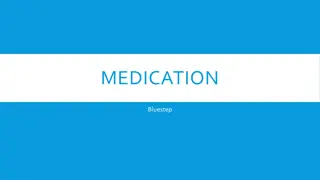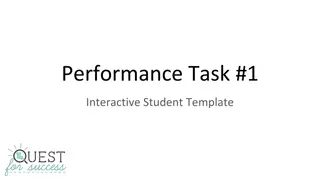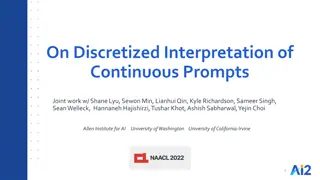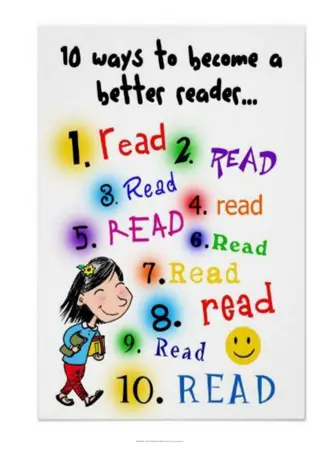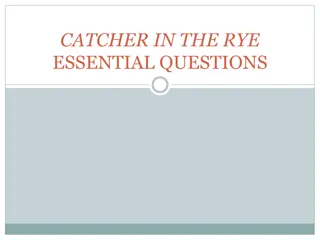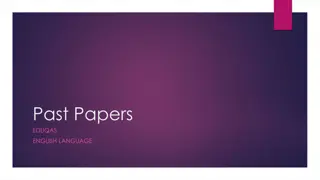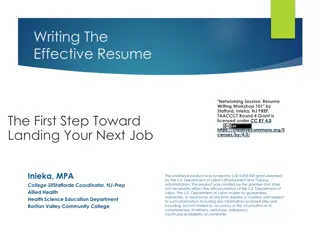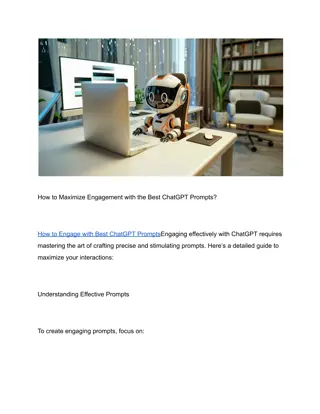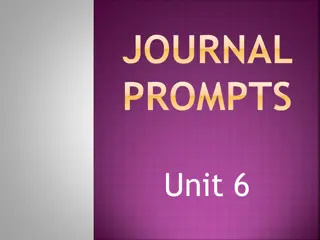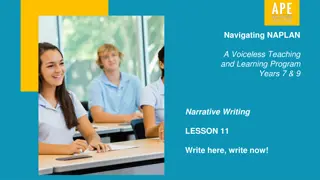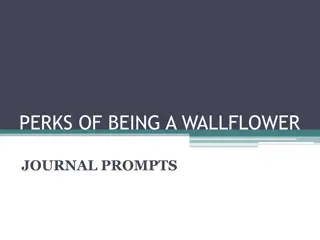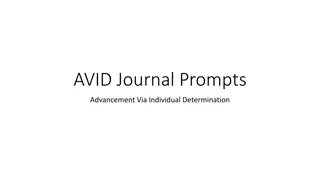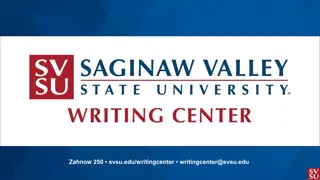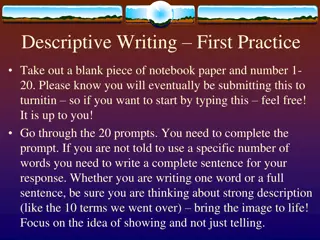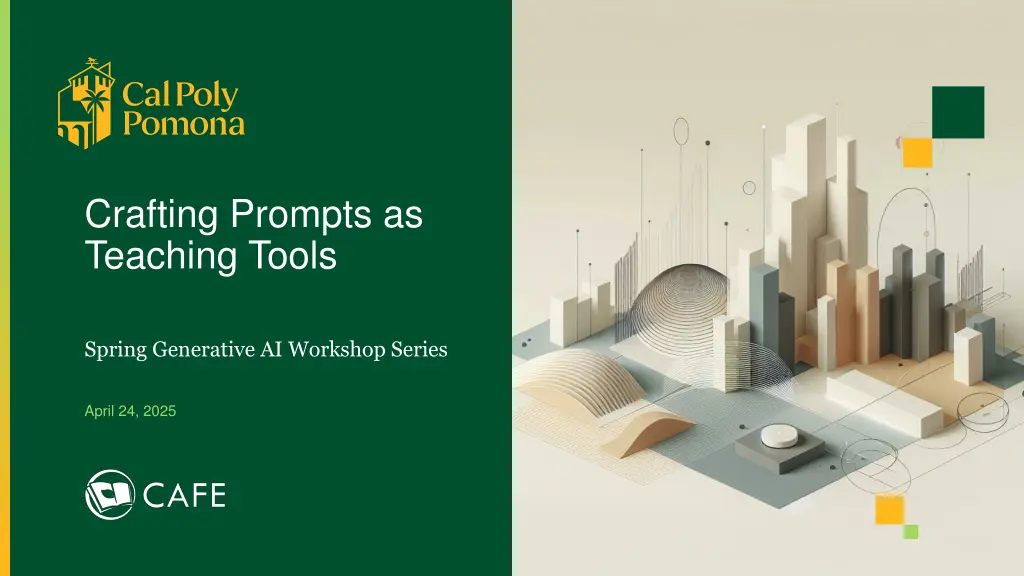
Crafting Effective Prompts for Teaching Success
Explore the art of crafting effective prompts for teaching in this insightful workshop series. Discover how to integrate prompts into pedagogy, understand AI chatbot generation, and learn the components of successful prompts. Engage with practical examples and hands-on activities to enhance your teaching skills.
Download Presentation

Please find below an Image/Link to download the presentation.
The content on the website is provided AS IS for your information and personal use only. It may not be sold, licensed, or shared on other websites without obtaining consent from the author. If you encounter any issues during the download, it is possible that the publisher has removed the file from their server.
You are allowed to download the files provided on this website for personal or commercial use, subject to the condition that they are used lawfully. All files are the property of their respective owners.
The content on the website is provided AS IS for your information and personal use only. It may not be sold, licensed, or shared on other websites without obtaining consent from the author.
E N D
Presentation Transcript
Crafting Prompts as Teaching Tools Spring Generative AI Workshop Series April 24, 2025 1
Crafting effective prompts (15 min) Erick Zelaya, CAFE Integrating prompts into pedagogy (45 min) Agenda Jennie Watson, MA, EML Closing remarks and Q&A (15 min) Everyone 2 2
They are not search engines! Chatbots generate content, hence the g in gAI. The more specific you are in your instructions the more likely the chatbot will be able to generate output that meet expectations. Understanding AI Chatbots 3 3
Six Components for Effective Prompts 1. Task (mandatory)* 2. Context (important)* 3. Exemplars (important) 4. Persona (nice-to-have)* 5. Format (nice-to-have)* 6. Tone (nice-to-have) 4 4
[persona] + [context] + [task] + [exemplar] + [format] + [tone] 5 5
You are a foreign language instructor teaching a second-year Spanish course. Craft an email to a student who is having difficulty passing the course and has failed the first two quizzes. Include a paragraph that acknowledges their frustration with their busy schedule and provide three bullet points with potential resolutions. Utilize the attachment as an example of the voice that is regularly used with these students. However, use an empathetic tone that is both friendly and authoritative. [persona] + [context] + [task] + [exemplar] + [format] + [tone] 6 6
Activity #1 #2 #3 + Format + Exemplars +Tone + Context + Persona Task only 7 7
Prompts for Educators 8 8
Course Policies and Syllabus In-Class Content and Scaffolding Assignment Directions Low-stakes Feedback How I m Using AI Problem Solving Drafting Letters of Recommendation Learning AI s Capabilities 9 9
Workshop Open ChatGPT (or another gAI tool) to use during our workshop Also beneficial: Sign in with CPP credentials Directions for an assignment Your syllabus 10 10
Basics Generative AI remembers previous prompts, so use follow-up prompts to get what you want Edit to Ask AI to remember key things Remember that I teach [courses] at a 4-year university. + Be aware that anything you submit (including your or students work) can be used to train 11 11
My Goals Improve effectiveness for current students needs Counteract the curse of knowledge bias Learn what you don t know you don t know Save time 12 12
Prompt Commands List Edit for Clarify Evaluate + + For example, Create + Include Time/length restrictions 13 13
Course Policies and Syllabus Adapt to students understanding and needs Edit the language in my syllabus to adapt to [first-year college students]. Use [an approachable, but academic] tone that helps students [feel like it is aimed at them instead of administration]. 14 14
Course Policies and Syllabus Benefits first-generation and neurodivergent students Say what you mean (including exceptions) Edit [my late work policy] to keep [the high expectations for timely work] but to [allow students to conference with me if the need arises]. 15 15
Course Policies and Syllabus Increase awareness and make conscious judgments Evaluate the course policies below [from an anti-racist lens, for equity, etc.]. Course Policies: [copy and paste from syllabus] List options for attendance policies that emphasize the importance of in-class learning by doing, but that also allow flexibility for individual student s circumstances. 16 16
Try It Edit the language in my syllabus to adapt to __ students. Use __ tone that helps students feel like __. Syllabus: [copy/paste] Edit __ to keep __ but to __. Policy: [copy/paste] Evaluate the course policies below for/from ___. Course Policies: [copy and paste from syllabus] List options for __ policies that emphasizes __, but that also __. 17 17
In-Class Content and Scaffolding Help students begin or get from one step to another Save time by compiling best practices 18 18
In-Class Content and Scaffolding My students are struggling with [reading comprehension of academic texts]. Create [a scaffolded assignment; a 15- minute in-class workshop] to [help students learn new strategies and improve their existing skills]. 19 19
In-Class Content and Scaffolding List options for adapting my lecture on [the Toulmin Model of Argumentation] into an engaging 40- minute workshop. Create a guide on [paraphrasing evidence and citing sources] with rules, examples, and common mistakes to avoid. Use the topic of [banning plastic water bottles] for the examples. 20 20
In-Class Content and Scaffolding Outline a plan for the next three 50- minute classes to [guide students through beginning and planning a research essay]. Also include in-class workshops that students can submit as homework before the next class meeting. 21 21
Try It My students are struggling with __. Create __ to help students __. List options for adapting my lecture on __ into an engaging 40-minute workshop. Create a guide on __ with rules, examples, and common mistakes to avoid. Use the topic of __ for the examples. Outline a plan for the next three 50-minute classes to __. Also include in- class workshops that students can submit as homework before the next class meeting. 22 22
Assignment Directions Clarify directions (curse of knowledge) Create assignments for practice or assessment 23 23
Assignment Directions My students are learning [how to create arguable claims]. Clarify my assignment directions: [copy and paste assignment directions]. Create a [study guide for a midterm; a multiple- choice quiz; an analogy] based on [the attachment]. Include [basic concepts and sample questions]. 24 24
Assignment Directions Create an assignment in which students [practice correcting comma splices and fused sentences]. The assignment should take [20-30 minutes] to complete. Include [editing strategies and examples] in the directions. Use [a pop culture] topic for [the sentences they should edit and the examples] and an [academic] tone. Make their responses easy for me to grade. 25 25
Try It My students are learning __. Clarify my assignment directions: [copy and paste assignment directions]. Create an assignment in which students ___. The assignment should take __ minutes to complete. Include __ in the directions. Use ___ topic and a __ tone. Make their responses easy for me to grade. Create a __ based on __. Include __. 26 26
Low-Stakes Feedback Note: Not good enough yet Create a rubric for [the assignment below] for a total of [10 points]. Include [content, organization, and formatting]. Create 4-5 different feedback options for different levels of success, from students who excelled down to students who did not understand the directions or did not submit. Use an [encouraging] tone. 27 27
Try It Create a rubric for __ for a total of __. Include __. Create 4-5 different feedback options for different levels of success, from students who excelled down to students who did not understand the directions or did not submit. Use a __ tone. 28 28
Problem Solving List strategies I can use to help me [give meaningful, useful feedback to my students in less time]. List ways I can [increase student motivation and engagement] in [a lecture-based class; a challenging multi- step project]. Explore ethical considerations for [grading group projects]. 29 29
Generative AI Capabilities List prompts I can type into ChatGPT to help me improve my assignments/instructions, content, pedagogy, and curriculum in my first-year college composition course. What information do I need to include in my prompt for [generative AI] to help me ______? 30 30
Test vague and specific prompts Assist reading comprehension How I m Asking Students to Use gAI You don t know what you don t know Improve student skills 31 31
Sample Prompts for Students Summarize the attached article to an 8th grade reading level. Explain [difficult concept] to a 10-year-old. What is included in the topic of ____? What cultural and historical context should I be aware of when I m writing about ____? I need to _____. Break the project into smaller manageable tasks. (Follow up: Break ____ into more specific tasks) 32 32
Addressing Ethical gAI Use Clear gAI policy in syllabus Discussion with students: When is gAI helpful and when is it cheating? Real-world consequences of over-relying on gAI Require citations for all use of gAI Ask students to complete work in OneDrive and share a link to show the version history 33 33
Q&A 34 34
THANK YOU 35 35 Cal Poly Pomona | Presentation Title


